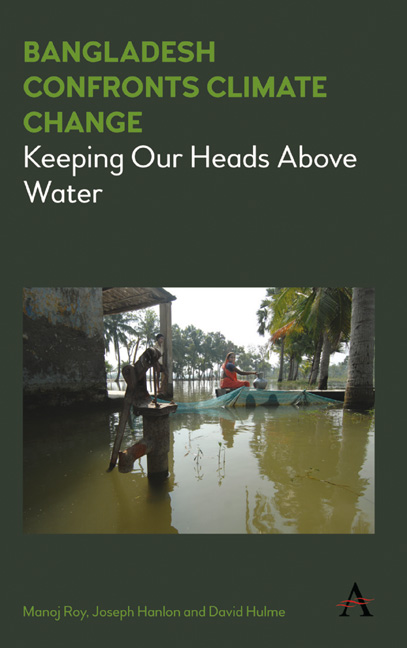Book contents
- Frontmatter
- Content
- List of Illustrations
- Abbreviations, Acronyms and Bangladeshi Terms
- Acknowledgements
- About the Authors
- Chapter One Actors, Not Victims
- Chapter Two How Will Climate Change Hit Bangladesh?
- Chapter Three Taking the Lead in Negotiations – and Moving Forward
- Chapter Four Sea Level Rise and the Vulnerable Coast – Where Farmers Know More than Engineers
- Chapter Five Saving Lives with Cyclone Shelters
- Chapter Six Living with Floods
- Chapter Seven Agronomists Keeping Ahead of Climate Change
- Chapter Eight No Climate Change Migrants – Yet
- Chapter Nine How Can the Privatized Megacity Cope with Climate Change?
- Chapter Ten Is Climate Change Only a Problem for the Urban Poor?
- Chapter Eleven Power – Political, Financial and Electrical
- Chapter Twelve Bangladesh on the Front Line of Climate Change
- Index
Chapter Six - Living with Floods
Published online by Cambridge University Press: 22 July 2017
- Frontmatter
- Content
- List of Illustrations
- Abbreviations, Acronyms and Bangladeshi Terms
- Acknowledgements
- About the Authors
- Chapter One Actors, Not Victims
- Chapter Two How Will Climate Change Hit Bangladesh?
- Chapter Three Taking the Lead in Negotiations – and Moving Forward
- Chapter Four Sea Level Rise and the Vulnerable Coast – Where Farmers Know More than Engineers
- Chapter Five Saving Lives with Cyclone Shelters
- Chapter Six Living with Floods
- Chapter Seven Agronomists Keeping Ahead of Climate Change
- Chapter Eight No Climate Change Migrants – Yet
- Chapter Nine How Can the Privatized Megacity Cope with Climate Change?
- Chapter Ten Is Climate Change Only a Problem for the Urban Poor?
- Chapter Eleven Power – Political, Financial and Electrical
- Chapter Twelve Bangladesh on the Front Line of Climate Change
- Index
Summary
The three-storey municipal office building collapsed into the river in July 2013. In three years all the Chowhali upazila municipal offices, the police station, the Bangladesh Rural Development Board office, a hospital and health centres, several schools, 20 km of paved road – and all flood protection barriers – were eaten by the river. The Brahmaputra-Jamuna is 12 km wide at this point and is called a ‘braided river’, with multiple constantly changing channels separated by alluvial islands. Chowhali upazilia is 100 km northwest of Dhaka and had been comfortably east of the river. After 2008 the river opened a small channel near the town which became a major channel and the huge increase in water flow rapidly eroded the east bank of the river and the town centre disappeared into the Jamuna river.
The Brahmaputra enters the north of Bangladesh from Assam, India. Historically it flowed east of Dhaka and into the Meghna. But in the late eighteenth century the Brahmaputra river changed course at the point where it enters Bangladesh, and shifted some of the main flow into the Jamuna river which joins the Ganges-Padma west of Dhaka. This shift is continuing – in 1830 the new and old channels seemed to be equal, but in recent years the old Brahmaputra has much less water. Therefore the Jamuna is expanding, from 5.6 km wide in 1914 to 8.5 km wide in 1973 and 12 km wide in 2010. It was the widening river that devoured Chowhali upazila.
As the rivers erode the banks, some of the sediment is dropped in the channel, creating shoals that become islands known as chars. These chars are occupied by farmers, but they are under water during normal floods. Most chars last only a few years before they are washed away again, but some become permanent islands with trees and buildings. In 1992 it was estimated that nearly 2 million people lived on Brahmaputra-Jamuna chars. From 1973 to 2001 the total char area in the lower Jamuna increased by two-thirds, from 424 km2 to 710 km2, while the total river area increased from 686 km2 to 999 km2.
- Type
- Chapter
- Information
- Bangladesh Confronts Climate ChangeKeeping Our Heads above Water, pp. 77 - 88Publisher: Anthem PressPrint publication year: 2016



